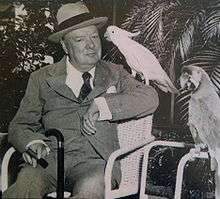Jungle Island
|
Jungle Island along the MacArthur Causeway | |
| Date opened |
December 20, 1936 (as Parrot Jungle) June 28, 2003 (at current location) |
|---|---|
| Location | Miami, Florida |
| Coordinates | 25°47′10″N 80°10′27″W / 25.78611°N 80.17417°WCoordinates: 25°47′10″N 80°10′27″W / 25.78611°N 80.17417°W |
| Website |
www |
Jungle Island (formerly Parrot Jungle) is an interactive zoological park in Watson Island, Miami, Florida, United States.[1] It was originally Parrot Jungle and moved from its original suburban Pinecrest to its present location just east of Downtown Miami renamed as Parrot Jungle Island. In 2007, the park was again renamed to Jungle Island.
History

Parrot Jungle was a zoological park south of Miami on 22 acres (89,000 m2) of property at Killian Drive and South Red Road.

Originally founded in 1936 by Franz & Louise Scherr, Parrot Jungle was one of the first tourist attractions established in the Miami area. The idea for Parrot Jungle began after Scherr, who owned and operated a feed and supply store in Homestead, became intrigued with the idea of building an attraction where birds would "fly free". Scherr leased 22 acres (89,000 m2) of hammock land for an annual fee of $25. Parrot Jungle was built as a winding nature trail dug through the coral rock and hammock land, indigenous to the area. All the natural plants were left undisturbed. The entrance was built on Red Road.
The attraction opened on December 20, 1936, to about 100 visitors. Each paid 25 cents admission to see and hear Scherr talk about his birds, trees and flowers. Since 1936, over a million visitors have visited Parrot Jungle.[2] Among its many famous visitors was Sir Winston Churchill,[2][3] film director Steven Spielberg, and former US President Jimmy Carter.[2] On December 17, 2002, the Village of Pinecrest purchased the Parrot Jungle with the aim of developing the site as Pinecrest Gardens. On March 8, 2003 the Pinecrest Village Council dedicated Pinecrest Gardens and officially opened it to the public as the Village's newest municipal park, without the animals that had made the park famous. The actual attraction moved to a new waterfront location on Watson Island between Downtown Miami and South Beach. It opened on June 28, 2003 as Parrot Jungle Island.
On June 28, 2007, four years after the park first opened at its bayfront location, Jungle Island became the official name.
Features

The theme park's landmark are its sails covering the Jungle Theater, an arena where visitors encounter wildlife from all over the world. On the other side of the theater lives Hercules, the 900-pound liger, a cross between a lion and a tiger. The park is also home to a trained bird show at the Parrot Bowl, and an exhibition of reptiles, penguins, flamingos and other animals at the Serpentarium.
In the Parrot Bowl, Jungle Island's "Winged Wonders" show highlights birds from around the world, including the Andean condor, cassowary (the only trained cassowary in the world), and king vulture.
The Jungle Theater has the "Tale of the Tiger" show, featuring large cats and wildlife.
In the "Serpentarium" (named in honor of Bill Haast's famed Miami Serpentarium), a wide spectrum of animals are presented – from African penguins to alligator snapping turtles, boa constrictor snakes to lemurs. Various other animal feedings, keeper talks and casual presentations are conducted throughout each day on Jungle Island.
There is a petting zoo where visitors can interact with a number of domestic and exotic animals, including an experience with red kangaroos.
The park's "Everglades Habitat" recreates the ecosystem of the Florida Everglades, featuring much of the natural flora and fauna found in the natural environment.
The entire facility was planted without the use of any artificial fertilizers or pesticides, making it one of the few entirely sustainable theme parks or zoos in the United States.[4]
Environmental efforts
In recent years Jungle Island has taken center stage on the greater Miami and the beaches environmental movement. In addition to avoiding the use of artificial fertilizers and pesticides, Jungle Island purchases carbon credits to offset special events.[5] Jungle Island also plays host to a number of large environmental conferences and events - including the annual Gateway To Green,[6] Energy Smart Florida,[7] and Earth Miami.[5]
Jungle Island supports a number of not-for-profit organizations, most notably The Everglades Foundation and EcoMB.[5]
References
- ↑ "Miami Parks and gardens". Retrieved March 18, 2010.
- 1 2 3 Gittmer, Cory H. (2000). Miami's Parrot Jungle And Gardens: The Colorful History of an Uncommon Attraction, University Press of Florida
- ↑ Village of Pinecrest 'Village History'
- ↑ Environmental Protection Agency 'Jungle Island's Holistic Approach to Landscape Site Development'
- 1 2 3 Earth Miami On Jungle Island
- ↑ City of Miami Gateway To Green
- ↑ Sun Sentinel Business Networking In South Florida
- http://www.usatoday.com/travel/news/features/2003/2003-07-15-parrot-jungle.htm
- http://www.nytimes.com/2003/07/27/travel/travel-advisory-miami-s-parrots-get-a-bigger-jungle-island.html
External links
| Wikimedia Commons has media related to Jungle Island. |